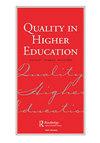批判性社会研究:重新审视质量
IF 1.1
Q3 EDUCATION & EDUCATIONAL RESEARCH
引用次数: 1
摘要
抽象通常被解释为将对物体世界的感官知觉升华为概念范畴。也就是说,从(字面上的)客观世界开始,识别重复的或明显的核心或定义特征,直到形成抽象概念。因此,例如,“就业能力”被解释为一套“技能”,使一个人得到一份工作。这种从一组观察对象中提取某些特征的过程是大多数分类系统的基础。批判性社会研究的出发点是事实不能独立于其理论背景而存在。如果事实不是自明的,那么概念就不能从中抽象出来。因此,批判性社会研究通过从抽象到具体的转变而起作用。它从抽象的概括开始,并在更广泛的背景下研究它们。例如,在家中,丈夫推搡、殴打或向妻子扔东西的攻击性行为被概括为“家庭暴力”。批判性的社会研究超越了家庭暴力作为一系列侵略行为的表面表象,并将其重新定义为,例如,父权控制的结果。抽象,对于批判性的社会研究来说,不仅仅是指定具体的组成部分,它需要识别潜在的结构,这些结构已经被不加批判地吸收到概念中,目的是发展一个重建的概念。因此,批判社会研究中的抽象不同于实证主义的使用,因为抽象不是简单地为现象的排序和最终具体化提供基础,而是用来深入到现象的表面之下。离子通常被解释为对物体世界的感官知觉进入概念范畴的升华。也就是说,从(字面上的)客观世界开始,识别重复的或明显的核心或定义特征,直到形成抽象概念。因此,例如,“就业能力”被解释为一套“技能”,使一个人得到一份工作。这种从一组观察对象中提取某些特征的过程是大多数分类系统的基础。批判性社会研究的出发点是事实不能独立于其理论背景而存在。如果事实不是自明的,那么概念就不能从中抽象出来。因此,批判性社会研究通过从抽象到具体的转变而起作用。它从抽象的概括开始,并在更广泛的背景下研究它们。例如,在家中,丈夫推搡、殴打或向妻子扔东西的攻击性行为被概括为“家庭暴力”。批判性的社会研究超越了家庭暴力作为一系列侵略行为的表面表象,并将其重新定义为,例如,父权控制的结果。抽象,对于批判性的社会研究来说,不仅仅是指定具体的组成部分,它需要识别潜在的结构,这些结构已经被不加批判地吸收到概念中,目的是发展一个重建的概念。因此,批判社会研究中的抽象不同于实证主义的使用,因为抽象不是简单地为现象的排序和最终具体化提供基础,而是用来深入到现象的表面之下。本文章由计算机程序翻译,如有差异,请以英文原文为准。
Critical social research: re-examining quality
ion Abstraction is usually construed as the distillation of sensory perception of the world of objects into conceptual categories. That is, starting from the (literally) objective world, recurrent or apparently core or defining features are identified until an abstract concept is formulated. Thus, for example, ‘employability’ is construed as the set of ‘skills’ that enable a person to get a job. This process of distillation of some features from a set of observed objects is at the basis of most systems of classification. Critical social research starts from the view that facts do not exist independently of their theoretical context. If facts are not self-evident then concepts cannot be abstracted from them. Critical social research thus works by moving from the abstract to the concrete. It starts with the abstract generalisation and investigates them in a broader context. For example, aggressive behaviour in the home in which a husband pushes, hits or throws things at his wife is encapsulated by the term ‘domestic violence’. Critical social research goes beyond the surface appearance of domestic violence as a set of aggressive acts and reconceptualises it as, for example, an outcome of a patriarchal control. Abstraction, for critical social research, is more than specifying the concrete components, it requires identifying underlying structures, which have been assimilated uncritically into the concept, with the aim of developing a reconstructed concept. Abstraction in critical social research, therefore, differs from the positivist use because, rather than simply providing the basis for ordering appearances and ultimately reifying them, they are used to get beneath the surface of appearances.ion is usually construed as the distillation of sensory perception of the world of objects into conceptual categories. That is, starting from the (literally) objective world, recurrent or apparently core or defining features are identified until an abstract concept is formulated. Thus, for example, ‘employability’ is construed as the set of ‘skills’ that enable a person to get a job. This process of distillation of some features from a set of observed objects is at the basis of most systems of classification. Critical social research starts from the view that facts do not exist independently of their theoretical context. If facts are not self-evident then concepts cannot be abstracted from them. Critical social research thus works by moving from the abstract to the concrete. It starts with the abstract generalisation and investigates them in a broader context. For example, aggressive behaviour in the home in which a husband pushes, hits or throws things at his wife is encapsulated by the term ‘domestic violence’. Critical social research goes beyond the surface appearance of domestic violence as a set of aggressive acts and reconceptualises it as, for example, an outcome of a patriarchal control. Abstraction, for critical social research, is more than specifying the concrete components, it requires identifying underlying structures, which have been assimilated uncritically into the concept, with the aim of developing a reconstructed concept. Abstraction in critical social research, therefore, differs from the positivist use because, rather than simply providing the basis for ordering appearances and ultimately reifying them, they are used to get beneath the surface of appearances.
求助全文
通过发布文献求助,成功后即可免费获取论文全文。
去求助
来源期刊

Quality in Higher Education
EDUCATION & EDUCATIONAL RESEARCH-
CiteScore
3.30
自引率
14.30%
发文量
32
期刊介绍:
Quality in Higher Education is aimed at those interested in the theory, practice and policies relating to the control, management and improvement of quality in higher education. The journal is receptive to critical, phenomenological as well as positivistic studies. The journal would like to publish more studies that use hermeneutic, semiotic, ethnographic or dialectical research as well as the more traditional studies based on quantitative surveys and in-depth interviews and focus groups. Papers that have empirical research content are particularly welcome. The editor especially wishes to encourage papers on: reported research results, especially where these assess the impact of quality assurance systems, procedures and methodologies; theoretical analyses of quality and quality initiatives in higher education; comparative evaluation and international aspects of practice and policy with a view to identifying transportable methods, systems and good practice; quality assurance and standards monitoring of transnational higher education; the nature and impact and student feedback; improvements in learning and teaching that impact on quality and standards; links between quality assurance and employability; evaluations of the impact of quality procedures at national level, backed up by research evidence.
 求助内容:
求助内容: 应助结果提醒方式:
应助结果提醒方式:


